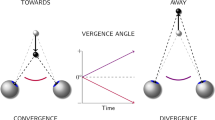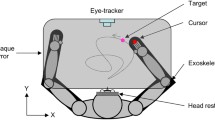Summary
Several investigators have reported that voluntary pursuit of a moving object is less smooth when it moves over a textured background compared with when it moves over a dark background. Furthermore, when a person fixates a stationary target on a moving background, microdrifts of the eyes occur in the direction of motion of the background. These two facts suggest that OKN is not completely switched off during voluntary pursuit or fixation. Howard and Simpson (1989) found that optokinetic nystagmus (OKN) is only weakly evoked by moving stimuli which are out of the plane of convergence. This led to the prediction that voluntary pursuit of a visual target should be disrupted more by a stationary background in the same depth plane than by a background which is nearer or further away than the pursuit target. Pursuit disruption was measured by the frequency and total amplitude of saccadic intrusions. For horizontal pursuit, disruption was reduced, compared with the coplanar condition, when the textured background was further away than the target but not when it was nearer. For vertical pursuit, disruption was reduced in both the far and near conditions compared with the coplanar condition. In both cases disruption was least when the background was dark.
Similar content being viewed by others
References
Barnes GR, Crombie JW (1985) The interaction of conflicting retinal motion stimuli in oculomotor control. Exp Brain Res59: 548–558
Collewijn H, Tamminga EP (1986) Human fixation and pursuit in normal and open-loop conditions: Effects of central and peripheral retinal targets. J Physiol 379: 109–129
Collewijn H, Tamminga EP (1983) Human smooth and saccadic eye movements during voluntary pursuit of different target motions on different backgrounds. J Physiol 351: 217–250
Grasse KL (1991) The effect of positional disparity on motion responses of neurons in the accessory optic system of cat. Soc Neurosci [Abstr] 17: 1380
Howard IP, Gonzalez EG (1987) Optokinetic nystagmus in response to moving binocularly disparate stimuli. Vision Res27: 1807–1817
Howard IP, Ohmi M (1984) The efficiency of the central and peripheral retina in driving human optokinetic nystagmus. Vision Res 24: 969–976
Howard IP, Simpson WS (1989) Human optokinetic nystagmus is linked to the stereoscopic system. Exp Brain Res 78: 309–314
Keller EL, Khan NS (1986) Smooth-pursuit initiation in the presence of a textured background in monkey. Vision Res26: 943–955
Kowler E, Murphy BJ, Steinman RM (1978) Velocity matching during smooth pursuit of different targets on different backgrounds. Vision Res 18: 603–605
Murasugi CM, Howard IP, Ohmi M (1986) Optokinetic nystagmus: The effects of stationary edges, alone and in combination with central occlusion. Vision Res 26: 1155–1162
Murphy BJ, Kowler E, Steinman RM (1975) Slow oculomotor control in the presence of moving backgrounds. Vision Res15: 1263–1268
Robinson DA (1963) A method of measuring eye movement using a scleral search coil in a magnetic field. IEEE Trans Bio-Med Engin BME 10: 137–145
Steinman RM, Haddad GM, Skavenski AA, Wyman D (1973) Miniature eye movements. Science 181: 810–819
ter Braak WG (1936) Untersuchungen über optokinetischen Nystagmus. Arch Neerl Physiol 21: 309–376
van den Berg AV, Collewijn H (1986) Human smooth pursuit: effects of stimulus extent and of spatial and temporal constraints of the pursuit trajectory. Vision Res 26: 1209–1222
Yee RD, Daniels SA, Jones OW, Baloh RW, Honrubia V (1983) Effects of optokinetic background on pursuit eye movements. Invest Ophthal Vis Sci 24: 1115–1122
Author information
Authors and Affiliations
Rights and permissions
About this article
Cite this article
Howard, I.P., Marton, C. Visual pursuit over textured backgrounds in different depth planes. Exp Brain Res 90, 625–629 (1992). https://doi.org/10.1007/BF00230947
Received:
Accepted:
Issue Date:
DOI: https://doi.org/10.1007/BF00230947




